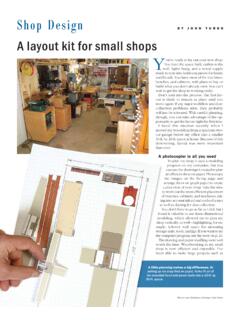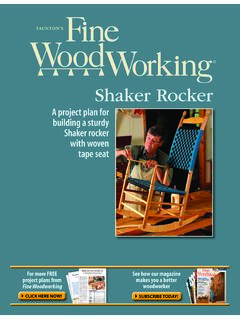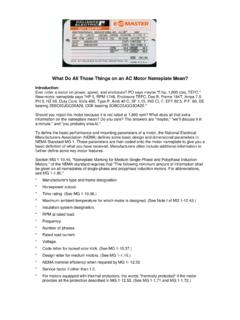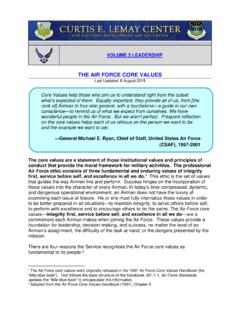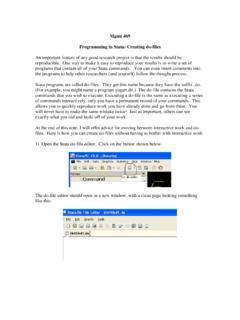Transcription of Dyes Can Do It All - Fine Woodworking
1 dyes Can do It All Color bare wood without blotching, tint topcoats, and touch up blemishes B Y T E R I M A S A S C H I. C oloring wood strikes terror in the hearts of most woodworkers. After spending six months build- ing a piece, potentially ruining it in an hour is a definite cause for anxiety. Much of this caution stems from bad experiences applying typical hardware-store wood stains to bare wood. These mostly pigmented stains can cause results that are too dark, blotchy, and muddy. Far from enhancing the wood, the effect is to ruin the appearance. Rather than throw out the baby with the bathwater and forswear ever coloring wood, switch to dyes . Like pigments, dyes also are called stains, but instead of lying on top of the wood like a pigment stain, they penetrate the wood. This ability enhances wood by TYPES OF dyes . dyes come in three main groups: as powders to be mixed with water, alcohol or mineral spirits;. in ready-to-use form as a non-grain-raising liquid.
2 Or as concentrates to be added to clear finishes. Each group has different uses and characteristics. POWDERED DYE NON-GRAIN-RAISING DYE. 44 fine Woodworking Photos: Mark Schofield COPYRIGHT 2006 by The Taunton Press, Inc. Copying and distribution of this article is not permitted. offering figure-revealing transparency. dyes come in a range of colors from subtle wood tones to brilliant primaries, and they can be applied to bare wood, combined with clear coats, or used as touch-ups. dyes come in powdered form, concentrates, and ready-to-use liq- uids. The trick is to know where and how to use each type. Dye bare wood for the greatest change in color whether you are seeking the rich tones of antique cherry or vibrant color on a more contemporary piece, you'll get the most impact by applying a dye to un- finished wood. however, this is something of a high risk, high reward situation. PICK A COLOR, Water-soluble dyes are your first choice The ANY COLOR.
3 Most commonly available dyes are powders dissolved While most woodworkers in water. often termed aniline dyes (although no longer reach for a wood tone made from this product), water-soluble dyes provide to give their pieces great flexibility in how they can be mixed and also how a more distinguished they can be used. or aged appearance, water-soluble dyes can be brushed, ragged, or brighter colors play an sponged on, or sprayed with a spray gun or a plant important role. Walnut mister. Their slow drying time means they can be ma- and mahogany are often dyed yellow before adding nipulated with a damp cloth to correct uneven color, a shade of brown to which makes them suitable for applying to large areas bring out the such as tabletops. They come in a greater range of color contrasts colors than any other type of dye, and if you can't find in the wood. the perfect color you can blend two or more dissolved Contemporary colors. Unlike many finishing products, dye powders furniture have an almost infinite shelf life if kept in the dark.
4 Makers use The main disadvantage of water-soluble dyes is their bright colors as tendency to raise the grain: Any water, whether clear accents, or to or dyed, will raise the grain when applied to bare make the whole piece stand out. TYPE SAMPLE BEST LESS THAN TOPCOAT. COMMENTS. OF DYE BRANDS USES IDEAL USE COMPATIBILITY. Lockwood, All finishes. Seal Widest range Waterborne Applied to Tinting other dyes Moser, with shellac before a of colors;. dye powder TransFast bare wood or clear finishes waterborne finish. cheapest dye Tinting Oil-based Lockwood, Will color-lift. Best for tinting oil-based Dyeing bare wood dye powder Moser finishes Seal with shellac. oil-based products Alcohol- Lockwood, Touching Will color-lift. Use concentrates based Dyeing bare wood Moser up color Seal with shellac. for tinting shellac. dye powder Solar-Lux, Mohawk All finishes. Add retarder for large Non-grain- Dyeing Tinting other dyes Ultra Penetrating If shellac, spray first surfaces; add reducer raising dyes Stain bare wood or clear finishes coat (gun or aerosol).
5 For lighter tones. TransTint, Tinting Staining All finishes. Dye Expensive but Wizard Tints, all clear bare wood If shellac, spray first concentrates goes a long way Sherwin-Williams finishes (must be mixed) coat (gun or aerosol). DYE CONCENTRATE. newoodwor k i n MARCh/APRIL 2007 45. COPYRIGHT 2006 by The Taunton Press, Inc. Copying and distribution of this article is not permitted. Dyeing bare wood gives the boldest results WATERBORNE DYE. wood. To get around this problem, raise the grain before applying dye. First, dampen the sanded surface with a cloth moistened with distilled water. Avoid tap water, as any minerals may react with tannin in the wood. Allow the wood to dry and then de-whisker the surface by lightly hand-sanding with the grain using P220-grit sandpaper. If you raise the grain and then smooth the surface, the dye will not raise the grain as much. The typical mix suggested by the supplier is 1 oz. of powder to 1 qt. of hot (not boiling) distilled water.
6 Because you are unlikely to need a quart of dye, the easiest way to measure fractions of an ounce is to use the plastic measuring cup that comes with liquid cough medicine (also available at pharmacies). These cups mea- sure volume, not weight; to account for this, fill slightly beyond the desired level when pouring in the dye powder. Allow the mix to cool, then strain it through a fine paint filter, or a plastic funnel lined with cotton cloth or a coffee filter. If you add way too much powder to the water, eventually no more will dissolve and you will end up with sludge at the bottom of the container rather like a pigment stain. If a dye this concen- trated is applied to the wood, it will leave a powdery residue. Raise the grain. Before applying a waterborne dye, the wood grain must Remove this residue with a cloth after it dries, or you may have be raised. Wipe the surface with a cloth dampened with distilled water. a problem when finishing over it.
7 After the wood is dry, lightly sand the surface with P220-grit sandpaper. Dissolve and strain the dye. Waterborne dyes should be dis- solved in hot water in the ratio of 1 oz. of dye to 1 qt. of water. The easiest way to measure smaller amounts of dye is using a plastic medi- cine cup (top right). After the mixture has cooled, pour the liquid through a fine paint filter to remove any grains of undis- solved dye (bottom right). Waterborne dyes can be applied with a cloth, sponge, paintbrush, spray gun, or plant mister (far right). 46 F I N E w o o d w o r k in g COPYRIGHT 2006 by The Taunton Press, Inc. Copying and distribution of this article is not permitted. NON-GRAIN-RAISING DYE. Apply fast-evaporating dyes quickly. Non-grain-raising (NGR) dyes need to be applied fast to avoid overlapping streak marks (above). However, you can blend away uneven NGR color by wiping the surface with a damp cloth (right). dyes for bare wood that resist fading Another type of dye suitable for bare wood is classified as a metallized or premetallized dye.
8 Commonly known as non-grain-raising (NGR) stains, their big- gest benefit is superior lightfastness compared to waterborne dyes . Away from intense light, waterborne dyes work fine , but NGRs are better near a sunny window (for more on lightfastness of dyes , see FWW #187, pp. 120-21). A second advantage is that there is no need to raise the grain before applying an NGR dye. NGRs come ready to use in a blend of ethanol, methanol, and retarder. Common brand names are Solar-Lux, Mohawk Ultra Pen- etrating Stain, and Super Penetrating NGR stains. This same dye is also available as a concentrate under brand names TransTint, Wizard Tints, and Sherwin-Williams Dye Concentrate. You can use these to tweak the color of the non-concentrated NGRs to augment their rather limited range of colors. To dilute NGRs, it is best to use a purpose-made extender. The easiest way to apply NGRs for even color tone is with a spray gun. Applied by hand, they are more troublesome because of their rapid evaporation.
9 On a large project, it is difficult to work fast enough to maintain a wet edge and avoid streaking, and at the same time achieve an even color density. To deal with streaking, Spray NGR dye for you can add 10% of a purpose-made retarder to slow down the best results. With drying time, and while the stain is still damp, to some extent you the gun set up to apply a fine spray, can even out the color with a water-dampened cloth. you can apply thin layers of color until Tint a clear finish for added flexibility you achieve the So far we have covered dyeing bare wood only, but you look you want in an also can add dye to a clear finish. You'll save a little time by even density. newoodwor k i n M arc h / A pril 2 0 0 7 47. COPYRIGHT 2006 by The Taunton Press, Inc. Copying and distribution of this article is not permitted. For subtle color, tint the finish dyes are often used to bring out the best in figured woods, but what if you don't want to alter the overall color of the piece?
10 The board on the left had an alcohol-based dye applied to the bare wood, and was then clear coated. While the figure is enhanced, the overall tone has darkened considerably. The board on the right was finished with Danish oil tinted with an oil-based dye dissolved in mineral spirits. The figure pops but the overall color is almost the same. DYE APPLIED DYE ADDED TO. TO BARE WOOD CLEAR FINISH. OIL-BASED FINISHES. applying the dye and finish in one step, but the main advantage is a more subtle shift in color. The result is comparable to the filters placed in front of lights in theaters, casting a delicate hue over the whole set. A wonderful use for tinted oil finishes is on highly figured woods. Most people use oil to pop the stripes in tiger maple, for example, but if you apply a tinted oil, it will make the stripes much more pronounced without coloring the whole board as much. To tint an oil-based finish, it's best to use an oil-based dye powder, although somewhat confusingly the powder must be dis- solved in mineral spirits and not oil before being added to the clear finish.

